No Creative Blocks – Painting Grief and Loss
Even if I want these blog posts to be a celebration of art-making, I also want to paint and write from the heart. This week’s post is about sadness and its’ effects on creativity.

Here’s my latest acrylic painting called “If Grief Smoked.” Like many of the recent paintings, this also has a connection to a poem. The title is from Eeva-Liisa Manner’s poem “Jos suru savuaisi.” But this time, I didn’t follow the poem but used the title as a prompt only.
Missing Cosmo
I have been very melancholic this fall, and to be honest, building a new class Floral Freedom, has been my savior. It’s been a captivating escape from a life that feels emptier than before. My loyal companion Cosmo died in September, and it’s like a part of me has lost a purpose.
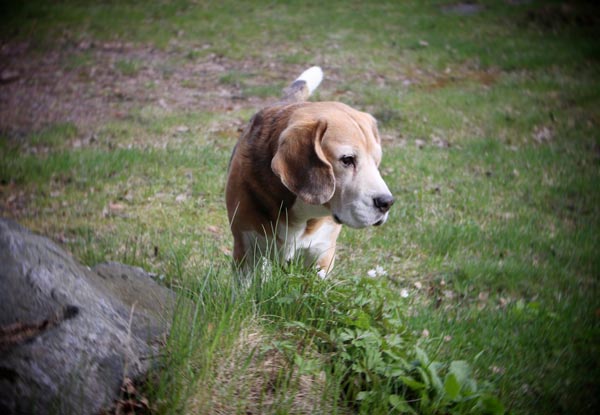
Cosmo was our family member for over 15 years, and there’s a lot I miss about him. Small things, often quite insignificant ones, like how he used to pick a sock when he wanted attention. My heart breaks when I remember how softly he did that, not leaving a single mark. In the end, he was a good dog and didn’t want to behave badly.
So yes, my grief has been smoking and burning. A wind of time has taken some away but also spread it further. When it started to feel that the grief would scorch my brushes, destroy the paints, and make the studio a smoky place, I knew it was time to paint. Not that it would take the grief away, but force me to deal with it.
Persuasion Can Replace Inspiration
Art is not always about inspiration. You know Picasso’s saying that the inspiration has to find you working. I find self-persuasion especially useful. “After this, you can paint whatever you want,” I said to myself.
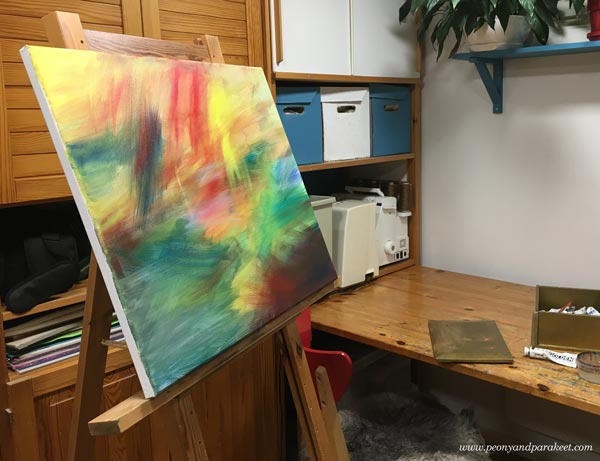
If we don’t paint these paintings that need to come out, it can cause a creative block. I have had some major ones in the past, and I didn’t want that to happen now.

“Follow the color,” I said to myself like many times before. It’s a quote of my own that boosts my confidence when I am working.
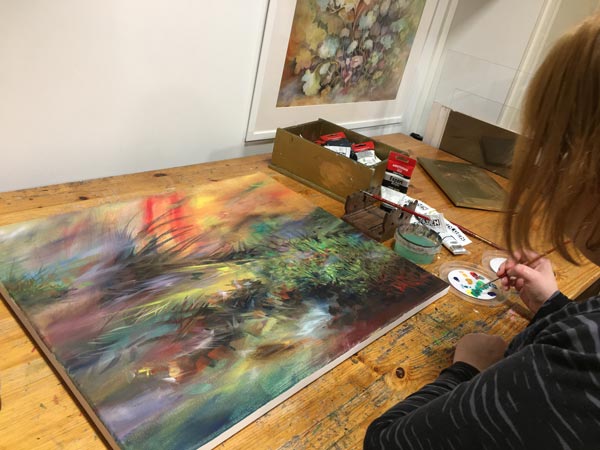
Stepping Into The Painting
This scenery had been in my mind for weeks. It was like an overdue baby, pushing through the brush.
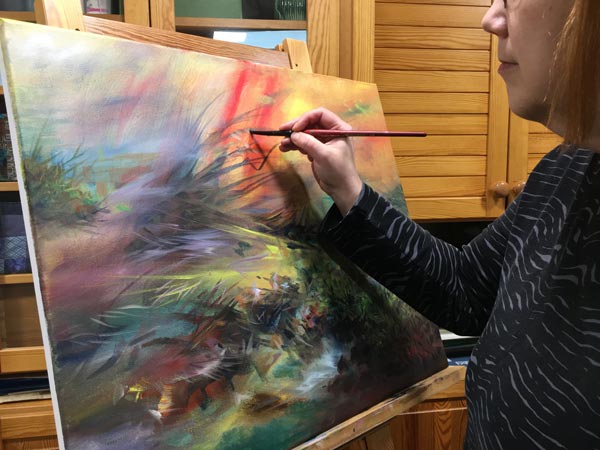
I just had to open my heart and welcome it.
Wassily Kandinsky talks about a glass between the artist and the painting, and how to remove it. It’s one of the hardest things when in grief, but also the most impactful one.

When we paint without the glass, the image becomes more personal. It doesn’t matter what other people think about it because you are living and breathing it. But oddly so, removing the glass also makes the image more general. My loss gets connected to everybody else’s losses. We are all behind the same glass, under the same blanket.
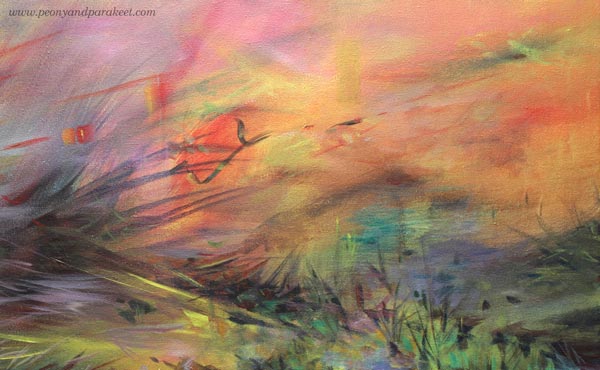
If grief smoked, we would all be covered in it. Even if it’s the saddest thing, it’s also beautiful to let go of someone or something you love. You can no longer help them, and it’s time to give them away.
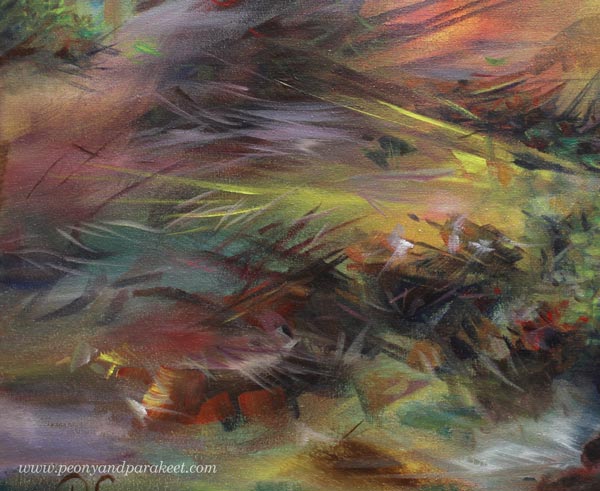
Mental Queue – Images That Need to Get Painted
Art helps us with things that can’t be solved intellectually. I also think that artists have a mental queue. If we try to jump over the hard images, we don’t have the energy for the more cheerful ones that come next.
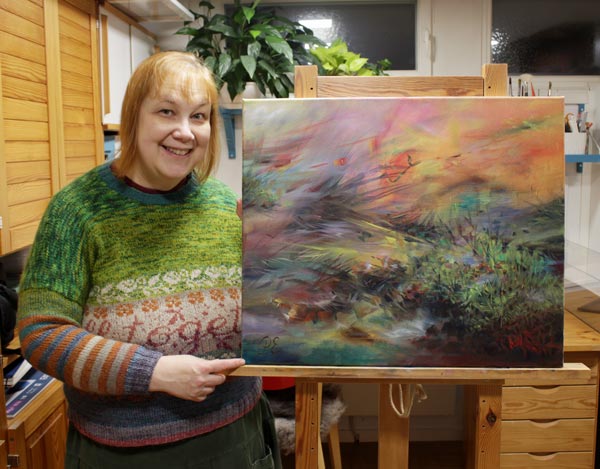
I hope this inspires you to pick the brush and paint the image that has been waiting for its turn.
Painting Poems – Watch the Video!
This week, we’ll continue the theme of painting poems from a couple of weeks ago. I create a small painting from a poem in a video and also talk about overcoming perfectionism.
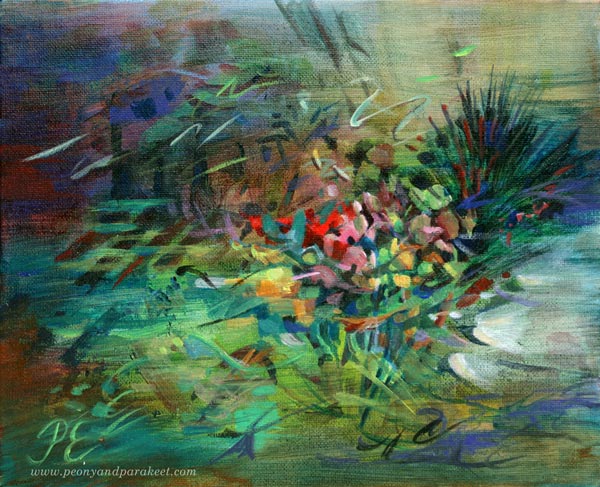
Here’s the acrylic painting that I created from Saima Harmaja‘s old poem “Olkoon niin!” I also include some examples from the class Floral Freedom at the end of this post.
Painting Poems – Watch the Video!
In the video, I show how a poem can make a painting more finished and meaningful. I also talk about why I thought I can’t paint Finnish poems and how I have realized that aiming for perfection doesn’t always help.
More Poetic Paintings
I created these two paintings for the class Floral Freedom. The first one is inspired by Anna-Maija Raittila’s poem Ruiskukkaehtoo (Cornflower Night).
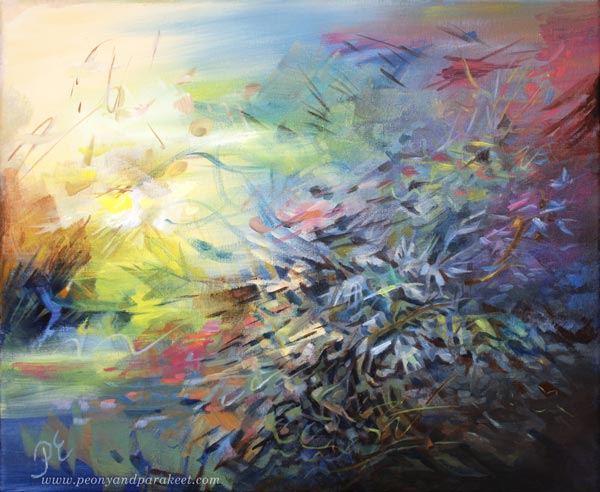
And the one below is inspired by Katri Vala’s poem Kukkiva maa (Flowering Earth).
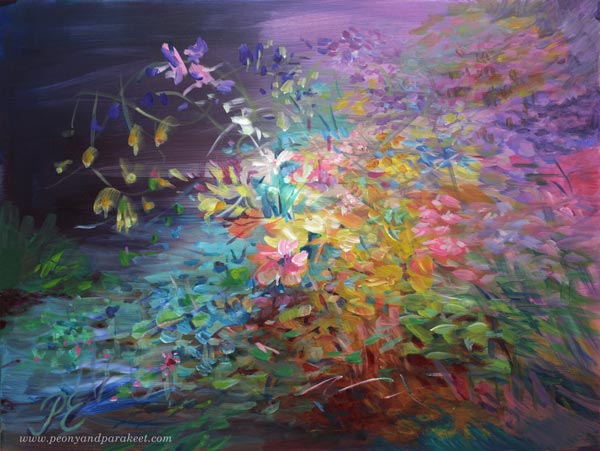
Paint Dreamy Florals to Free Your Spirit!
Floral Freedom – the abstract floral class based on Paul Klee’s and Wassily Kandinsky’s insights – will begin on Dec 4, 2021. In this class flowers are not just passive decorations, but they fly, sing, and dream! >> Sign up Now!
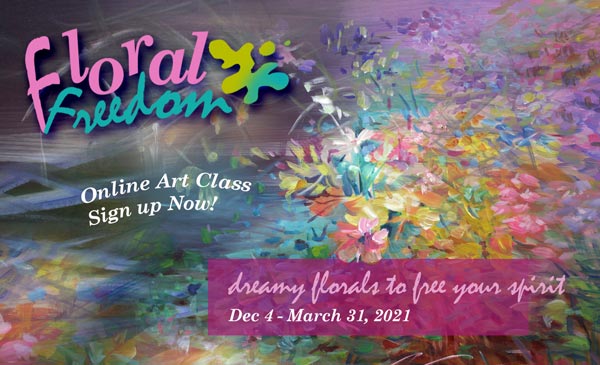
Floral Freedom is 20% off for the rest of November, so now is a good time to sign up!
>> Sign up now!
Using Leftover Paint – Messy Backgrounds and Beyond
This week, I show one of my art journals in the video and share ideas for what to create from messy backgrounds.
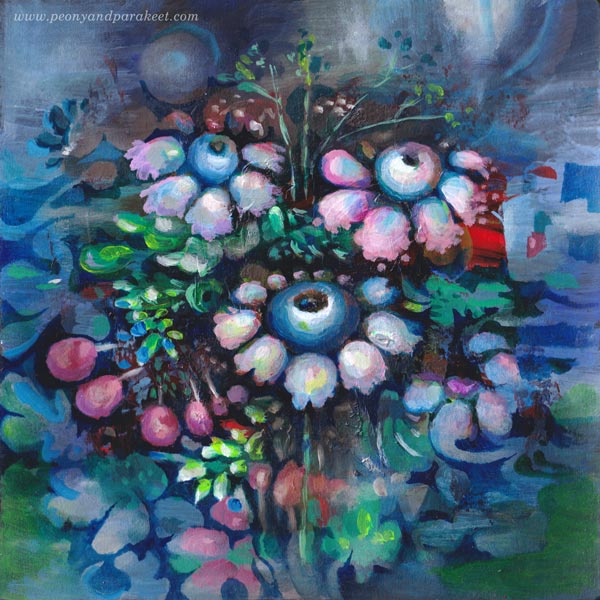
After a painting session, there’s usually some leftover paint on a palette. I try to squeeze the tubes carefully, and sometimes I put the paint in a box with a lid, but most often, I grab an art journal and wipe off the extra paint from the brushes and palette. If I am tired, I just spread the paint carelessly. If I still have energy, I add details to a page that already has some color. When I don’t like something in the next session, I paint new strokes over it.
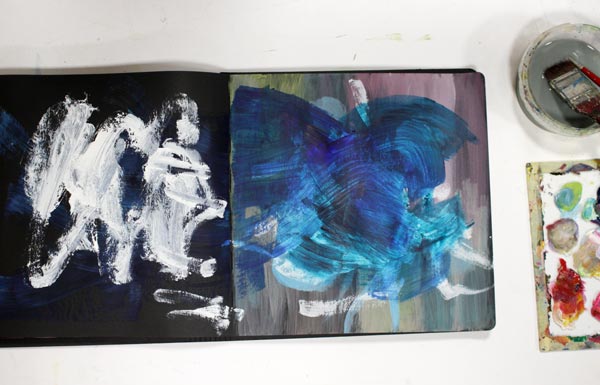
Many Rounds – Some Quicker than Others
I rarely make a page at one go. This spread has oil paints, and it took ages to finish it. But it didn’t matter, because I was practicing for the class Decodashery, and I needed time to dig into the heart of decorative painting style.
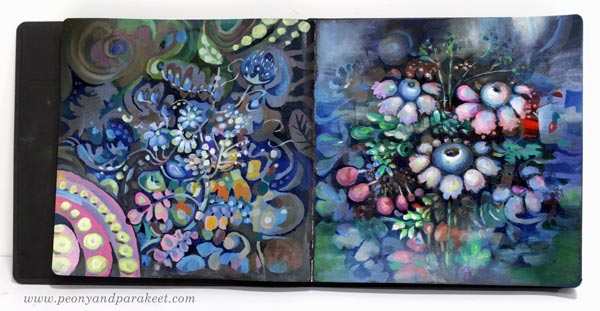
However, the one below is more abstract, and it was really quick!
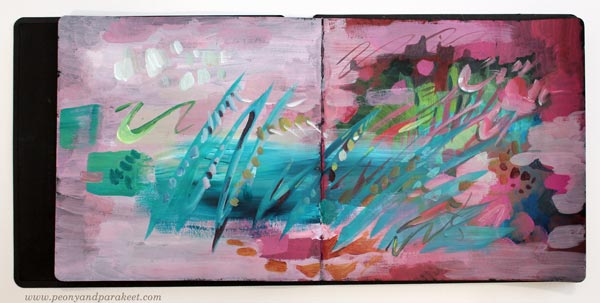
Messy Backgrounds and Beyond – Watch the Video!
In the video, I show messy pages and not so messy pages of my current art journal and how I finished the spread above. Watch the video!
Even if bigger paintings are my main work, art journal pages are an important part of my creative process. It’s like yin and yang! I need the mess-making to find joy in working with details.
Art Inspired by Music
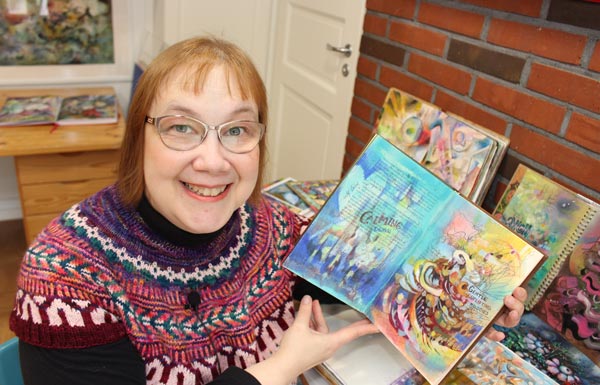
In the video, I mentioned the idea of visualizing a musical landscape and a melody. Music is the theme in my mini-course for Gratitude Junk Journal 2020 as well. This online workshop has 12 instructors, and it begins on Nov 1st, 2020. Register in October to get 20% off. Enter JOY2020 at checkout. >> Buy Here!
Paint a Poem!
This week, we’ll talk about poems and how to turn them into paintings!

This acrylic painting is called “Terät liitävät kirsikkapuista,” and it’s my interpretation of Valter Juva’s poem from 1902.
The Finnish name is a bit difficult to translate. Terät liitävät have a double meaning: 1) blades flying in the air 2) petals falling freely. Namely, a petal – terälehti – is a compound word in Finnish. Terä is a tip or a blade. Lehti means a leaf.
This is not the only language-related thing in the poem, and I struggled with the translation. But here’s the best I could do!
English Translation of Valter Juva’s Poem
| Terät liitävät kirsikkapuista, ja virta vieno ne vie. Se tyynine suvantoineen mun onneni kymi lie. | Edges fall from cherry trees and are caught by a gentle stream. The river and its pools are the well of my serene. |
| Suviyössä, mi tuoksuu ja värjyy, veet kultahan sulautuu; se lekkuu lännessä päivä ja idässä kuultaa kuu. | In the summer night, that smells and glows, waters melt in gold; in the west, the day is stirring, and in the east, shines the moon. |
| Niin hiljaist’ on ja tyyntä! Ja koskien alla veet ne ahtaassa piirissä viipyy, mut siinä on syvenneet. | It’s so quiet and calm! And under the rapids, waters dwell in a tight round but have become deeper and deeper. |
Passion for Poetry
When I was a teenager, poems were my passion in the same way drawing and painting have been. I used to read poetry, and almost daily, wrote my own. I even entered competitions, and some poems have been published. Later, this love for poems have reappeared occasionally: I have read or written some. In 2014, I even wrote a blog post about illustrating poems in art journaling.
But now, it feels that poetry has come to stay. Every time I open a big book (Runojen kirja – Book of Poems) that I won in a poem-writing competition in 1981, I see something that I want to paint. The book has over 800 pages filled with four centuries of Finnish poetry, but it’s not just that. With the book, I remember many poets that I used to read. My mind is blowing, and my brushes are jumping! “Paint paint paint,” they cry!
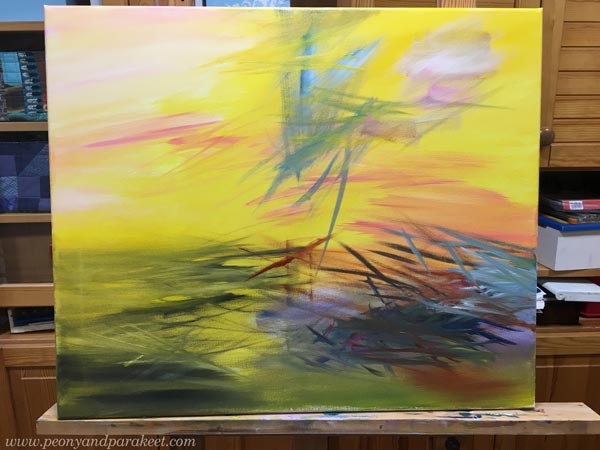
Valter Juva’s poem was new to me, but I got inspired right away. This painting has a lot of yellow in the background!
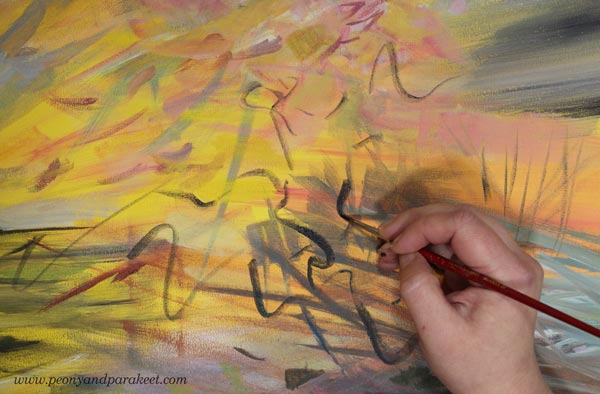
It was a joy to paint those sharp petals and curvy cherry trees that so willingly release the flowers. The size of this painting is 50 x 60 cm (about 19,5 x 23,5 inches) so I was able to paint the details more roughly and quite quickly.
Paint a Poem – Trust the Inspiration!
Painting a poem doesn’t have to be about illustrating every word. It can be more about finding a personal view – how the poem loosely explains your current life and often past experiences too.
In Valter Juva’s poem, the connection between Japan (cherry trees) and Finland (bright summer nights) blew my mind. You who have read my blog for a long time, know that both my husband and I love everything Japanese, and we also have a Japanese garden.
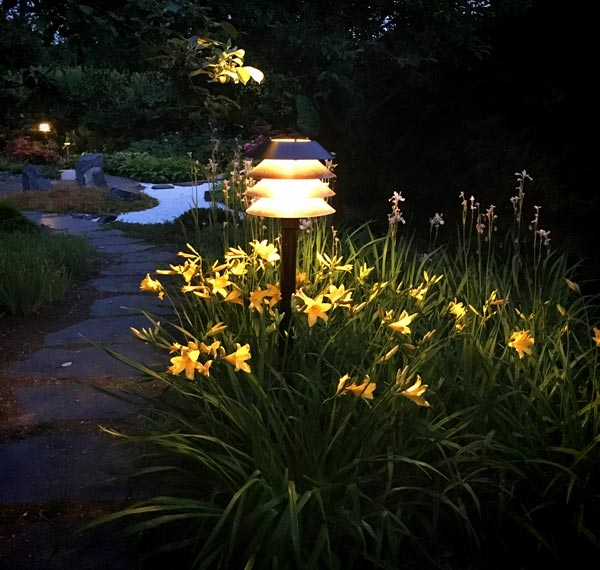
White nights were magical last summer! East and west meet like in the poem!
Paint a Poem – Color the Words!
Poems are filled with interesting words that can have a double meaning or a specific nuance. We don’t even have to know what strange words actually mean. It can still have a certain feeling to us, and we can express that with colors and shapes.

In Valter Juva’s poem, there’s a Karelian word lekkuu which means moving or stirring. To me, it has a relaxed undertone which makes me think about yellow-orange curves floating in the air, just above the water.
Paint a Poem – Break Borders!
In art, whether it’s poetry or painting, we can break borders. We don’t have to stick with one geographic location but create one that has characteristics of several places. Similarly, we are allowed to freely travel in time, from childhood to ancient history, and from the current moment to fantasy.
By changing the rules of reality, we can make representational elements symbolize more abstract things. They can be inanimate objects or nature’s elements, for example. In Valter Juva’s poem, waters have deep knowledge, In my painting, static trees take off and timid flowers jump from the plane.
Also, we can be magicians and make any material change its state. In the poem, water becomes gold, and in my painting, light is less immaterial and more touchable and concrete.
Poems are filled with metaphors, so why not let them in your paintings too!

Which poem would you like to paint?